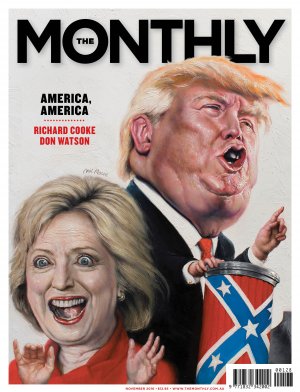Condamine River on fire in a CSG mining area, Queensland. © Max Phillips
Advertisement
From the front page
Between 2009 and 2015, the Adelaide-based oil and gas company Santos and its international partners spent $10,000 per minute on a $25 billion mistake. They had hoped that an enormous gas export plant at Curtis Island, just off Gladstone in Queensland, would generate profits almost as large as its climate footprint, but today the facility is worth billions of dollars less than they paid for it. Ouch.
They weren’t alone in their optimism, or their forecasting errors. As the world was allegedly striving to reduce fossil-fuel use, two other consortia built nearly identical “gas liquefaction” plants right next door to the Santos facility. All up, the three plants have cost a combined $80 billion. When plants in the Northern Territory and Western Australia are included, around $200 billion has been invested in the expansion of Australia’s gas industry in the decade since Kevin Rudd declared that climate change was a “great moral challenge”.
Australians have been told for decades that “businesses need certainty”, and that uncertainty is a barrier to investing in renewable energy. Unfortunately the gas industry’s inability to predict the future with any certainty didn’t prevent its managers from taking a massive risk with their own shareholders’ money.
More recently Australians were told that the carbon price would send their businesses broke. Compared to the cost of these companies’ incompetence the cost of a carbon price would have been trivial, yet all of those involved are still in business. Go figure.
But the gas industry’s investments don’t just affect its shareholders. They carry a heavy environmental cost. Compared to the conventional offshore rigs that most people associate with “natural gas”, coal seam gas (CSG), the new form meant to feed the enormous gas export facilities, does far more harm to our water, soil and air. Moreover, by driving up the local price of gas, the massive expansion has harmed Australian households, businesses and the manufacturing industry far more than the carbon price ever would have. And at the same time the gas industry has talked up its contribution to our budget, its accountants have driven down the amount of tax it pays. Well played, gas industry. Well played.
The physical scale of the $80 billion gas export facilities at Gladstone is hard to comprehend. They are made of enough concrete to build seven Empire State Buildings and enough structural steel to build 13 Eiffel Towers. Imagine if such ambition were aimed at building renewable energy rather than selling more fossil fuels.
Until the Gladstone facilities were built it was impossible to export gas extracted on Australia’s east coast. The fact that most of the country’s gas was “landlocked” meant that our abundant gas supplies were sold to Australians at well below the world price. But as soon as the east coast gas market was linked to the world market via the Gladstone facilities the price of Australian gas rose to meet the world price. For why would the gas industry sell Australian gas to Australians cheaper than they could sell it to the Japanese? Unfortunately for shareholders, however, something else that the gas industry forecasters didn’t see coming was that the world price of gas would collapse around the same time that the massive Queensland export facilities began to come online. So much for business needing certainty.
In the words of Ian Macfarlane, a former Coalition minister and the newly appointed chief executive at the Queensland Resources Council, “We’ve got to make sure that every molecule of gas that can come out of the ground does so.” Regardless, it seems, of the many costs.
Should the Gladstone gas plants hit full production in 2018 as planned, Australia is expected to become the largest exporter of liquefied natural gas (LNG) in the world. We are already the world’s largest exporter of coal, and in the past ten years our coal exports have doubled.
Australia isn’t “tackling” climate change, we are selling it.
The first step towards reducing greenhouse gas emissions is to stop increasing them. It’s not complicated. But the fact that the solution is easy to describe doesn’t mean that it’s easy to implement, especially when some of the most powerful industries in the world are determined to sell more oil, gas and coal.
Much has been written, by environmentalists and fossil-fuel lobbyists alike, about how hard the transition away from fossil fuels will be. Like most of what has been written about the economics of climate change, it’s wrong. Capitalism has many flaws, but if it does one thing well, it is to drive change when given the incentive to do so. It’s not economics, or capitalism, that is holding back change, it’s the lack of political will and skill to shift the incentives. Talking about “the enormous transition challenge” doesn’t help drive change; it simply helps conceal the fact that the problem is political, not economic.
The transition from horses to steam engines was a big task, but 19th-century Europe managed to pull it off pretty quickly. The transition from steam engines to internal combustion engines had its challenges too, but they didn’t need parliamentary inquiries or complex economic modelling to make it happen. More recently, the advent of mobile phones and then smartphones has created and destroyed hundreds of thousands of jobs in Australia and millions around the world. Few people worried about the “transition” away from landlines, or about the devastating impact on jobs in photo development labs from the arrival of digital cameras.
Of 24 million Australians, around 40,000 work in the coalmining industry. A further 20,000 people work in oil and gas. Those figures combined account for under 1% of the Australian workforce. To put that into perspective, more people work at Bunnings than are employed by the entire oil and gas industry. And there are more people employed in renewable energy than in our coal-fired power stations.
The transition to a zero-emission economy will not be easy or necessarily cheap, but then again neither was building a 7-kilometre stretch of export gas factories. Moving away from fossil fuels will likely be disruptive, but no more than free-trade agreements, the end of the Australian car industry or the arrival of the internet. As the fight between taxis and Uber shows, the hard part of transition isn’t motivating the new competitor, it’s stripping the incumbents of the regulatory protections that their political power has built for them.
But the power of the fossil-fuel industry isn’t the public power that comes with popularity, it’s the private power that everyone suspects and few have ever seen. Unlike free-trade agreements, privatisations and public sector cuts, all of which cost lots of jobs, investing in renewable energy and banning new gas wells have always been popular. But, like introducing same-sex marriage or banning junk food advertising, the fact that a large majority of the population want more reliance on renewables and less on fossil fuels is yet to translate into governments that take the majority opinion seriously.
Most people just aren’t cynical enough to see politics for what it is. When we accuse politicians of being “poll driven” we praise them unfairly. Poll-driven politicians might lack spine, but at least they are listening to the people they claim to represent. Serious politicians aren’t poll-driven. Serious politicians dismiss populism and tell the public to take their medicine, even if it’s bitter. And how do serious politicians know what is right, what is necessary and what the country really needs? That’s what lobbyists are for.
Martin Ferguson never studied engineering or chemistry. He never worked in a refinery or helped build a pipeline, but, apparently, “there are few people in Australia with such a comprehensive understanding of Australia’s oil and gas industry”. At least that is what Santos’ then CEO, David Knox, said in late 2013 when Ferguson took on the newly created role of chairman of the advisory board to the gas industry’s peak body, the Australian Petroleum Production & Exploration Association.
How could it be that someone with no academic or commercial experience in the gas industry could be described as being one of the most knowledgeable people in the country? Simple. Up until a month before his new job lobbying for the oil and gas industry, Ferguson had been a member of parliament. He was the Labor minister for resources who oversaw the scrapping of the mining tax mark I (the version the resource sector loathed) and the design of the mining tax mark II (the version that industry could “live with” because … it failed to collect any significant revenue).
Ian Macfarlane never studied geology and never worked in a coalmine. Before entering politics as the Liberal member for the Queensland seat of Groom, he was a farmer and the president of the Queensland Graingrowers Association. In his time on the Coalition front bench he held a number of portfolios, including industry, science and resources.
It was Macfarlane’s “magnificent achievement”, according to Tony Abbott, to help dismantle Labor’s mining tax, and upon Macfarlane’s retirement from federal politics in early 2016, Abbott implored the mining industry to look after a fellow traveller. “I hope this sector will acknowledge and demonstrate their gratitude to him in his years of retirement from this place.” Four months later Macfarlane was appointed as CEO of the Queensland Resources Council on a reported salary of around $500,000 per year.
Once upon a time the generous retirement benefits given to politicians were justified on the basis that a stint in politics was a career-limiting move. These days the opposite is true. A stint in politics is a great way to set up a lucrative career advising the industries that rely most heavily on government for their existence and their profits. Mark Arbib, the former ALP powerbroker, is director of business development and corporate affairs for James Packer’s Consolidated Press Holdings, while Peta Credlin, the former chief of staff to Tony Abbott, is head of policy and business development. Former deputy prime minister Mark Vaile is the chair of Whitehaven Coal, and Alexander Downer, our former foreign minister, was appointed by Gina Rinehart as her proxy to the board of Lakes Oil, where he sat alongside her other appointee to that board, climate sceptic Ian Plimer.
Politicians have skills that few people understand. Few people really know how other politicians think or how Cabinet really makes policy decisions. Even fewer people also know how the bureaucracy really works. The handful of people who have seen the inner workings of government are worth a fortune to those who wish to influence government decision-making. And Economics 101 tells us that the people willing to pay a fortune for such knowledge are the people who stand to make a fortune from those skills.
Where academics talk endlessly about “evidence-based policy” and NGOs spend a philanthropic fortune trying to show the public benefits of restricting gambling or taxing pollution, big business typically adopts quite a different approach. Big business typically starts with buying advice from former politicians and their staffers on the best way to get the decision they want. One sector must be on the wrong track.
The mining industry famously spent $20 million on advertising aimed at scrapping the mining tax, but business groups spend far more than that every year lobbying on issues you have never heard of and achieving concessions you couldn’t dream of. Raw displays of power such as the attack on the mining tax can work, but there are much more effective ways of getting what you want. While public relations relies on getting your message into the public eye, government relations usually relies on keeping your demands out of the public eye.
Politics is more like judo than boxing. Boxers try to knock their opponents out with fists alone. In judo the whole body creates a pivot on which the speed and strength of an opponent is used to throw them off balance. Just as the overwhelming momentum of the republic was thrown flat on its back by “little Johnny Howard”, and just as the marriage equality movement stares in disbelief that Cory Bernardi is on the brink of defeating them again, the fossil-fuel industry has been throwing the climate movement around the ring for 30 years. And within the fossil-fuel industry it is the gas industry that has managed to remain the smallest target that does the most damage.
There are no solar panels on the roof of St Peter’s Cathedral in Adelaide. But the sunlight that falls on the historic building illuminates another important source of power, the subtle power of the oil and gas industry in Australia.
The stained glass windows of St Peter’s don’t just depict the usual Christian symbols of rebirth and redemption. They also depict the commonality of mining operations and Christian thinking. Seriously, the brochure available at the church states, “The central window of the Santos set also celebrates modern mining technology … the ancient wheel of life doubles as the endless bucket-wheel of a mine, and in the shadows hide open cut mines and stratified drill cores – samples of the deep secrets of the earth.”
The “Santos set” refers to the stained glass windows paid for by the South Australian oil company. Like so many of our historic buildings, institutions and political parties, St Peter’s is sponsored by the oil and gas industry. The companies that rage against paying taxes that they claim would make them uncompetitive are never short of a dollar for a well-placed political donation or cultural sponsorship.
The pattern of such donations is as illuminating as the oil-tinted light that shines on the faces of St Peter’s parishioners. In addition to churches and symphony orchestras, bike races and fine food festivals are also prominent recipients of Santos support. While domestic violence shelters struggle to attract corporate largesse, the preferred pastimes of the powerful are rarely short of a sponsorship buck. Both major parties also received around half a million dollars between them from the oil and gas industry in 2014–15. (The absence of continuous disclosure laws means we are yet to learn what they dished out in the lead-up to this year’s federal election.)
Nearly 10,000 fracking wells now scar the landscape of Queensland and New South Wales. And unlike oil rigs in the open oceans, these wells are on farms and near communities. They leak methane, the primary component of the “natural gas” the gas industry is drilling for. They are joined up to pipes, compressors and tanks that leak even more methane.
While hundreds of thousands of dollars in donations might have helped get politicians onside, sponsored shade cloths at regional sporting grounds have done little to convince most farming communities that gas wells and farming are a healthy combination.
Having spent tens of billions of dollars on their new gas export facilities in Queensland, the gas companies need to feed their enormous beasts, and the only way to feed them is to drill more and more fracking wells. In their rush to spend their shareholders’ money there was no time to stop and get approval for all the fracking wells their enormous facilities would ultimately need, but given that Australian politicians always say yes to the resources industry, what could go wrong?
Robyn King has never seen herself as much of an “activist”. But in 2013, when the gas companies wanted to start drilling for CSG in the Upper Hunter region of New South Wales, the local farmer got worried, and then she got busy. She started by talking to her neighbours, and then, having discovered she wasn’t alone in her concerns, she and other volunteers knocked on doors in her Mullaley community and asked people’s opinions. The result of the survey was that 98.5% of people wanted the area to remain gasfield-free.
When it comes to investing in renewable energy or extracting more fossil fuels, Michael Fraser, the then managing director at AGL Energy, put it simply in 2014: “We walk both sides of the street if you like.” AGL was once one of the corporate darlings of the environment movement, in part because it was so publicly supportive of renewable energy. But when one of the dirtiest coal-fired power stations was put on the market at a bargain price, AGL couldn’t resist. And having bought one big coal-fired power station they went on to buy a few more. AGL are now the biggest owners of coal-fired power stations in Australia, they made the biggest windfall profits when Tony Abbott scrapped the carbon tax, and they were very, very keen to drill for CSG in Hunter Valley communities that were very keen that they didn’t.
The fossil-fuel industry has a long and profitable track record of getting its way. Sure, there have always been Aboriginal land owners and environmentalists to deal with, but the size and power of the industry combined with the weakness of their political opponents has typically meant that approval for resource projects has typically been a question of when, not if, in Australia.
In the past decade, things have shifted significantly. The efforts of determined individuals, and groups such as Lock the Gate, have prevented thousands more wells in Victoria, South Australia and the Northern Territory. In an unexpected win for public politics, New South Wales has hit the pause button on CSG exploration licences, and Victoria and the Northern Territory are talking about permanent bans. The gas industry wants to drill for CSG under the Coonawarra vineyards in South Australia but, so far, it has been held at bay.
The fact that new coal and gas proposals are under farm land, rather than indigenous land, has made a big difference. Like the oil industry, farmers are used to being listened to by Australian politicians and they don’t like being brushed aside. The Lock the Gate movement helped to put hundreds of small community groups in touch with one another, and they quickly realised they were all fighting the same companies on the same issues. They also realised that that many in the “farmers party”, the Nationals, were more pro–mining industry than they were pro–farming community.
AGL spent five years and millions of dollars on its plans to drill for CSG near Gloucester, north of Newcastle, but in February this year it announced it was walking away. AGL also announced it would wind up its CSG operations in Camden, where it had been extracting gas just hundreds of metres from family homes on Sydney’s fringe.
Near Lismore, on the NSW North Coast, the community also wore down Metgasco’s resolve to drill for gas at Bentley. Over three years, thousands had participated in protests and blockades. As events came to a head, in mid 2015, the NSW government had drawn up plans to deploy nearly 1000 police to break up the protesters. But the fears of local politicians combined with a falling price of gas prompted Metgasco, like AGL, to walk away from a project on which they had spent $120 million. They could have installed solar panels on 20,000 roofs for that, more than enough for every house in Lismore.
Yet the fight against CSG is far from over. Santos has a $2 billion plan to drill 850 gas wells around Narrabri in northern New South Wales. It needs to pour as much gas down the throat of its $25 billion monster in Gladstone as it can. The collapse in world prices means that Santos has to rely on big volumes to compensate for low prices.
Santos is an acronym for South Australia Northern Territory Oil Search, and it is deeply embedded in the business and political life of Adelaide. Where AGL had a brand to protect and Metgasco is a small player, Santos has relied on politics from its birth.
Today, two ex-Santos employees work in Malcolm Turnbull’s office. A senior adviser to NSW premier Mike Baird used to work for Santos. The company’s former head of government relations spent five years working for Ian Macfarlane when he was a minister. Its head of public affairs for eastern Australia worked for South Australian Liberal powerbroker Nick Minchin as well as Mark Vaile. The oil and gas industry employs just 0.2% of Australian workers but it seems to employ a much larger percentage of the political class.
Community concern about the expansion of gas drilling around Narrabri isn’t going away. But then again, neither are the banks that lent tens of billions of dollars to fund the Gladstone gas export hubs. Santos needs to drill a lot more gas to pay back a lot more money. The question is not whether Santos will stop trying but whether Australian politicians will stop it succeeding.
The showdown between Santos and the broader NSW community is yet to reach the fever pitch seen between Metgasco and the Bentley community, but that is because Santos is still lining up its troops. The NSW government recently passed legislation that created the new offence of “aggravated unlawful entry on inclosed lands”, effectively increasing fines for protesters. At the same time, the NSW government lowered the penalty for illegal mining activity from a $1.1 million fine to $5000 penalty notice. Lobbying works. If only the environment movement could afford the lobbyists who work for fossil-fuel companies.
The line between peaceful protest and trespass is a fine one in any democracy, which is why the lobbyists wanted to amend the legal definitions. The police are often called, which presumably is why Santos seeks to sponsor them as well. Seriously. As part of a road safety campaign there are police cars in Queensland with Santos logos on them.
With $80 billion worth of investments to recoup, the gas industry can’t stop trying. It is legally obliged to meet the contractual commitments to supply gas they are yet to gain the approval to extract.
Politics will decide how much harm the gas industry can do to our farms, our environment and our other industries. That’s why ex-politicians are so important to it.
Gas was once seen as a “cleaner fuel”, one that could help the world economy transition from its reliance on coal and oil to the zero-carbon economy required to prevent dangerous climate change. But those days are over. It is simply too late. Like many countries, Australia’s power stations, factories, cars and trucks are emitting far more emissions today than they were back in 1992 when we pledged our intention to reduce them. Over the same period, Australia doubled its coal exports.
Had the switch from brown coal to gas-fired electricity begun back when Paul Keating was prime minister it would have been a great start, but after 25 years of global inaction the climate science makes clear that there is no longer the time for a halfway house like gas. Not if there is any chance of keeping global temperature rises below 2 degrees Celsius.
If the remaining amount of greenhouse gas emissions we can put into the atmosphere is thought of as a “budget”, then we have already used up so much of that budget that there simply isn’t “room” in the atmosphere for decades of emissions from gas-fired power stations.
It gets worse. Not only is the gas industry too late, it is now too dirty. Up until the last decade, the vast majority of the world’s gas came from what are now known as “conventional” sources but were once simply known as oil and gas wells. Big holes were drilled into big reservoirs of oil and gas (the two are often co-located), and big amounts of fuel would come up under high pressure over years, or even decades.
But in the past 20 years billions of dollars have been spent refining “unconventional” ways to extract oil and gas from unconventional sources, including coal seams, shale seams and tar sands. Extracting energy from these sources does a lot more harm to the environment, to ground water, and to the climate. Needless to say, addressing such concerns are not a high order problem for those who profit from the sale of the end product.
Unlike the “conventional” gas extracted from the big oil rigs such as those found in Western Australia’s North West Shelf, fracked gas requires a mixture of water, sand and chemicals to be pumped into the ground to fracture (hence the term “fracking”) the rocks that trap the methane deep below the ground.
In addition to pumping chemicals such as benzene into the ground, the process of fracking coal seams can release naturally occurring substances such as lead, mercury and uranium into the surrounding soil and water. The fracking chemicals also help to keep the newly created fissures open so the methane gas can leak out. The process ensures that fracking wells capture a far smaller proportion of the gas that comes to the surface than is captured by “conventional” wells.
Despite a decade of widespread fracking in Australia, no comprehensive analysis of the extent of these “fugitive emissions” that seep through the soil and water and into the atmosphere has been published. The Australian government has chosen to estimate the level of fugitive emissions from CSG wells based on an assumption. The assumption is based on the level of fugitive emissions from conventional gas wells in the US. Where actual measurements have been taken of the fugitive emissions from unconventional gas wells in the US, the figures have been up to 25 times higher than the assumed figures used in Australia’s national inventory of greenhouse gas emissions – the figures used to tell the rest of the world what our contribution to climate change is.
Despite the fact that a tonne of methane is 20 times more potent as a source of global warming than a tonne of CO2, the Australian government and the Australian gas industry continue to assume that fugitive CSG emissions are low rather than collect evidence to the contrary.
YouTube and Facebook have done more to highlight the dangers of the gas industry than governments or traditional media. Footage of American householders burning the water that comes out of their kitchen taps has been viewed millions of times online. Here in Australia, a video of NSW state Greens MP Jeremy Buckingham setting the Condamine River on fire in southern Queensland has been viewed more than five million times. The video is as alarming as it is funny.
It’s hard for the gas industry to deny that gas is leaking up all over the place when videos taken all around the world make clear that gas is leaking up all over the place. But hard to deny doesn’t mean impossible.
Sure, the Condamine River has so much methane bubbling up that the river is now a fire hazard, but maybe it has always been there? Can the local farmers prove that the nearby fracking caused the gas to show up? Do the farmers have measurement data proving that the gas wasn’t in their water decades ago? No? Then let’s not jump to any hasty conclusions.
Rather than insist the gas industry proves that CSG drilling is safe and that it doesn’t cause high levels of pollution, or even earthquakes, the Australian government has reversed the onus of proof. In an ironic contortion of the idea of “evidence-based policy”, governments and industry are now demanding that communities prove that the gas leaking from their ground and water hasn’t been there all along.
Climate sceptics often argue that we shouldn’t trust climate scientists who are funded by government grants. But, strangely, those who worry that government funding might distort the findings of academics seem to have no such concerns when it comes to the fossil-fuel industry funding the work of CSIRO.
The task of monitoring the amount of the methane leaking from the ground as a result of fracking has fallen to CSIRO, but, despite the obvious public interest in such an evaluation, a consortium of the biggest gas companies in Australia funds much of this work. The Gas Industry Social & Environmental Research Alliance (GISERA) includes Santos, AGL, Origin and QGC plus a handful of other gas companies who all voluntarily contribute $150,000 per year to the joint venture. In return, the gas industry receives three representatives on the GISERA advisory committee and six representatives on the national research management committee, a committee on which neither environment nor farm groups have any representation.
After five years GISERA is yet to develop a specific methodology for estimating the amount of fugitive emissions associated with the production of coal seam gas in Australia.
But while the industry-funded research body tasked with monitoring methane leaks isn’t sure how much methane is leaking, they are sure that some of the biggest leaks, such as those filmed by Jeremy Buckingham, are not caused by fracking. In refuting Buckingham’s claim of a link, CSIRO’s Professor Damien Barrett, a GISERA director, stated, “The presence of the industry there has not caused that crack to occur or that fault to occur, it’s been there for aeons. The gas has probably been coming to the surface there for as long as people have been there.”
Farmers in the region claim that the gas bubbles in the river only became visible after fracking began nearby in 2012. Admittedly the farmers have no long-term methane measurements from the area to prove their point. But then again, if CSIRO, the gas industry or anyone else was serious about finding out whether fracking was safe or not, they would have collected extensive data before fracking commenced.
The gas industry has worked hard to downplay the risks to human health and the natural environment associated with the practice of pumping chemicals into the ground to release gas trapped beneath the surface. But at the same time as they were trying to downplay the risks of fracking, they were working just as hard to exaggerate the economic benefits of doing so.
Until recently, the gas underneath Australian soil could only be sold to Australian households and businesses, and because there was so much gas and so few potential customers its price here was very low for decades. Cheap energy, as was often said, gave us our “competitive advantage”.
Spending $80 billion on gas export facilities, on the other hand, meant that Australian gas could be sold on world markets at world prices. And, once the gas industry could sell some of their gas at the world price, why not sell all of it at the world price?
Back when a carbon price was introduced to increase the cost of all fossil-fuel use, the Australian business community, and the conservative press, raged against the impact of higher energy prices on the competitiveness of Australian manufacturing. They have been silent about the wholesale price of gas in Australia more than doubling.
As the Gladstone gas plants approached completion, the nature of financial disaster awaiting the gas industry began to emerge. The massive expansion of unconventional oil and gas supply around the world had pushed world oil and gas prices down, and while global gas prices were still higher than those that Australians had been paying, they were lower than the accountants had been assuming, and much lower than shareholders had been promised.
Around the same time, it was becoming obvious that the CSG wells in Queensland were not coughing up as much gas as had been assumed. Even though Australian gas extraction was at an all-time high, the Gladstone gas plants were going to need a lot more CSG wells to feed them. And they were going to need them fast.
But AGL and Metgasco had given up on their fight with NSW communities, and the NSW government called for more evidence before it would grant any new CSG exploration licenses. The Victorian government announced a ban on fracking. The NT Opposition promised to do likewise soon before it swept to power in September.
So the gas industry again went on the offensive. It blamed the environment movement for causing a “shortage” of gas, and, with characteristic chutzpah, claimed that the best way to get gas prices back down would be to approve new wells.
The harshest, most inconvenient, truth is that given a choice our elected representatives would prefer to avoid a fight with the fossil-fuel industry than lead a fight to rapidly reduce our greenhouse gas emissions. Take the response of the political class to the mid-latitude cyclone that ripped 22 electricity transmission towers from the ground in September and plunged the entire state of South Australia into a blackout.
Rather than reflect on the enormous costs of our ongoing failure to address climate change, the loudest conservative voices took a leaf out of the gas industry playbook and went on the front foot. It wasn’t coal-fuelled climate change that Australians needed to fear, but renewable energy.
But while the absurdity of Barnaby Joyce et al was much discussed, few commentators and even fewer citizens heard the gas industry whispering in the background. The real solution, the federal minister for energy, Josh Frydenberg, told the nation after the emergency meeting of his state and territory counterparts, was a greater reliance on gas. In August, the same ministers had met to discuss a failure of another element of the electricity grid, the so-called interconnector between South Australia and Victoria, and concluded, you guessed it, that the solution involved a greater reliance on gas.
The gas industry has lobbyists everywhere. The gas industry has former staff everywhere. And when the main determinant of the gas industry’s future profits is the decisions of today’s politicians, you can bet that no matter what the problem, someone will argue that the answer is gas.
It’s not climate change that needs to be tackled in Australia; it is the entrenched political power of the fossil-fuel industry. And unfortunately for those paying attention to the climate science, that battle has barely begun.



















Comments
Comments are moderated and will generally be posted if they are on topic and not abusive. View the full comments policy.